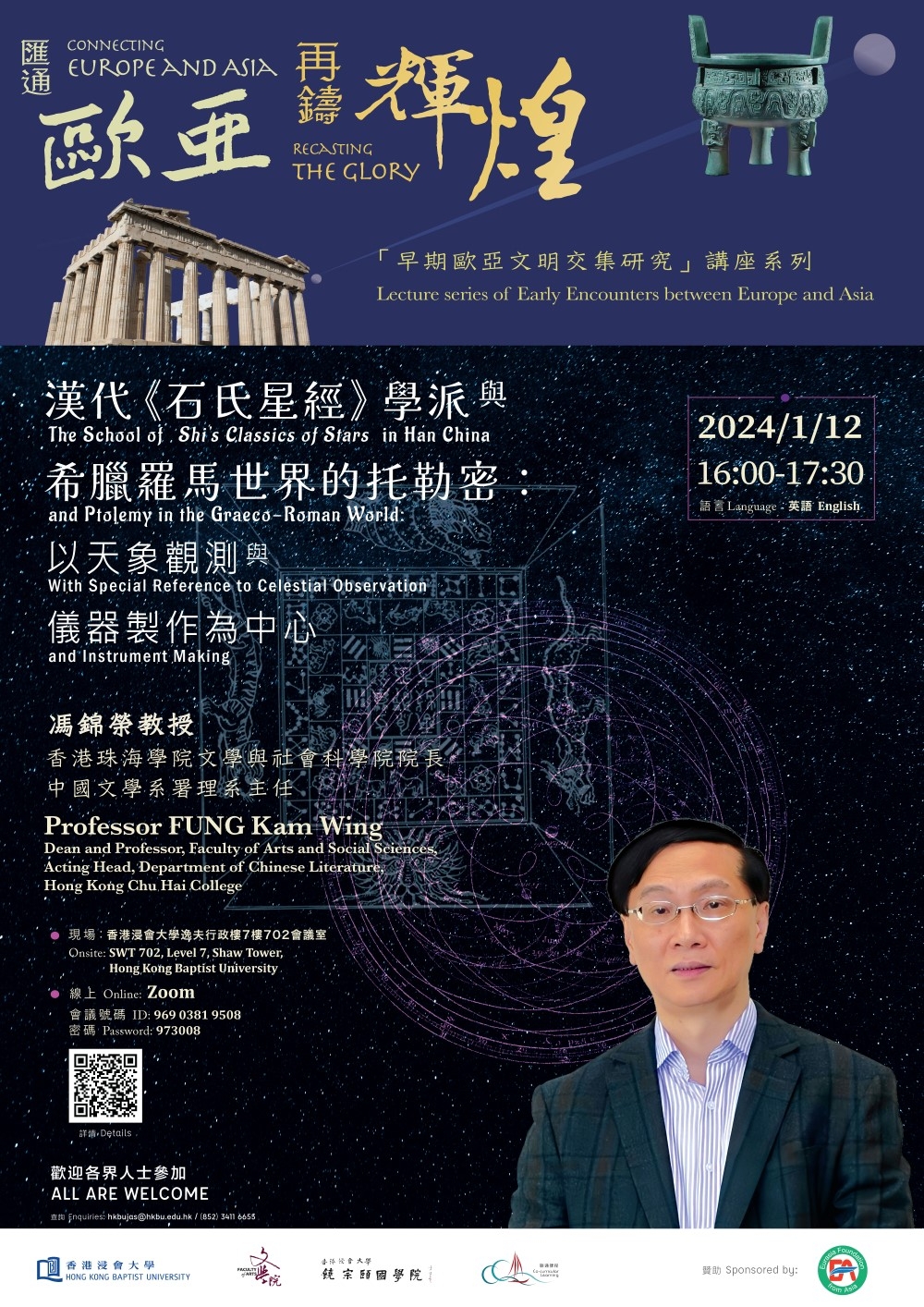
Connecting Europe and Asia, Recasting the Glory: Lecture series of Early Encounters between Europe and Asia
Lecture 14: The School of Shi's Classics of Stars in Han China and Ptolemy in the Graeco-Roman World: With Special Reference to Celestial Observation and Instrument Making
2024/1/12│16:00–17:30
Professor FUNG Kam Wing
Dean and Professor, Faculty of Arts and Social Sciences,
Acting Head, Department of Chinese Literature,
Hong Kong Chu Hai College
- Abstract: According to Sima Qian’s司馬遷Shi ji 史記 (Historical Records), Master Shi Shen石申 ( or Shi Shen Fu石申夫, fl.370B.C.-340B.C. ) was an astronomer and astrologer of the State Wei魏in the Late Warring States Period (403B.C.-221B.C.). As a key member of Shi Shen’s Astronomical School in Eastern Han Dynasty, Zhang Heng 張衡 (78-139) was renowned in astronomy, seismic study and instrument making. Ptolemy (c.100-178) of Graeco-Roman world, was widely regarded as Zhang Heng’s contemporary and well accomplished in both astronomy and cartography. With the aid of Dunhuang manuscripts and historical documents discovered along the Silk Road, this lecture will demonstrate astronomical traditions of Han China and Graeco-Roman world and their cultural encounters in the first millennium.
- Language: English (supplemented by Putonghua)
- Summary (Recorded by Guan Jinglin)
Professor Fung Kam Wing of Chu Hai College in Hong Kong brought for us a lecture titled: ‘The School of Shi's Classics of Stars in Han China and Ptolemy in the Graeco-Roman World: With Special Reference to Celestial Observation and Instrument Making.’ In it, through comparison of Zhang Heng of the Chinese Han dynasty and Ptolemy of the Graeco-Roman world in respect of astronomy, geography, and instrument making, Professor Fung expounded traditions of astronomy in China and the West, and the history of the first millennium of cultural exchange between them.
First, Professor Fung introduced several concepts of the Chinese Qin and Han dynasties related to the system of thought embodied in the Heaven-mankind duality, for example, ‘Heaven and mankind’, ‘qi energy’, ‘the yin-yang polarity’, and others. Yang Xiong infused Confucian ideology into these and formulated the philosophy of taixuan (supreme mystery), creating for the first time a notion of ‘the ideal Confucianist’. Professor Fung indicated that, grounded in the system of concepts expounded by Yang Xiong, Ming dynasty individuals, for example, Matteo Ricci, Li Zhizao, and Bi Maokeng, were the earliest to compare Zhang Heng and Ptolemy in respect of the three principles of Heaven, earth, and mankind.
Following this, Professor Fung explained three types of pre-Qin scholarly theories in relation to the Universe: those of ‘Heaven as an encompassing lid’, ‘Heaven as an encompassing sphere’, and ‘the infinite Universe’. These theories shared a close relationship with pre-Qin, Qin, and Han notions of ‘the rites of sacrificing to Heaven’, ‘the craft of rulership’, and ‘governance by astronomy’. Based on this foundation, Professor Fung furnished a detailed exposition of Zhang Heng’s scientific achievements. Zhang, according to his understanding of the Universe, produced the Taixue lun (Commentaries on Supreme Mystery), Xuantu (Diagrams of mystery), Dixing tu (Diagrams of geographical features), and Huntian yi tuzhu (Commentaries on diagrams of instruments for demonstrating Heaven as an encompassing sphere). He advocated a ‘proposition for the formation of primal qi energy’ of ‘the supreme basis’. His achievements in the realm of instrument manufacture also had a definitive influence on calendrical formulation. In addition, Professor Fung also drew comparisons between elements in the Dunhuang manuscripts related to astronomy, the Japanese Heian era text Shishi xing guan bu zan (Master Shi’s star catalogue), and a book on silk excavated in Mawangdui Tianwen qixiang zazhan (Miscellany of divination by astronomical and meteorological phenomena), and these display achievements in the field of astronomy of the Chinese Han dynasty.
Following this, Professor Fung introduced the scholarly fruits of Ptolemaic astronomy and the surviving remnants of them as discovered along the Silk Road. Ptolemy composed works discussing astronomy, mathematics, and divination that included Planisphaerium, Almagest, and Tetrabiblos, and these were important guides to ancient Arabic and European astronomers. His propositions and assemblage of Graeco-Roman astronomical instruments, for instance, the notion of the earth as the centre of the Universe, and map projections, for example, conic projection, and spherical projection, were widely accepted and used by subsequent generations. They were possibly even transmitted into China, like the Roman sundial and astrolabe, and so on and so forth.
Professor Fung’s lecture was detailed in content and rigorous in textual evidence. In its understanding of astronomy and related traditions of schools of thought, it fused China and the West and was well-versed in both ancient and modern.